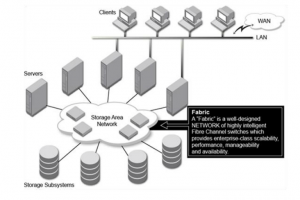What is Fibre Channel
In few words Fibre Channel combines the best of two worlds. It’s a channel transport that shares best of the characteristics of an I/OI bus (like SCSI), as a consequence hosts and applications see the disk devices as locally attached storage. But Fibre Channel also incorporates the best of the network as FC allows multiple protocol support, such as SCSI, IP, FICON.
At the beginning, when storage was connected directly to servers, it was a good solution due to high-speed channel from server to storage (most often SCSI Bus). The biggest limitaion was 15 devices for BUS. The limitation also was with sharing the data, clustering etc.
Due these limitations there was a need for network flexibility, keeping up the channel performance, as a block level data. These are the origins of the Storage Area Network (SAN). The dominant technology used in modern SANs is Fiber Channel. Biggest benefits of FC are:
- Speed up to 16 Gbit/sec
- Initiator negotiates for access before transmitting to the target, which gives channel-like access to the target
- all SCSI commands and user data is sent over 212 bye Fibre Channel payload frames
Fabric => SAN
Fabric is a collection of Fibre Channel switches, Directors, and connected devices, such as server hosts and storage. Fabric is an most popular implementation of SAN.
SAN Components
SAN provides any-to-any connectivity in the fabric. SANs employ fiber optic and copper connections to create dedicated networks for servers and their storage systems. To do so, there are couple of components needed:
- Fibre Channel Switches and/or Directors – note, the smalles Fabric is just one switch
- HBAs (Host bus Adapters) – HBAs are similar to NICs (Network Interface Card). There are used to connect devices to Fabre Channel Switches. They replaced SCSI controllers.
- Storage System
- Optical cables
- Management Software
- Tape Drives – for backup purposes
In couple of next entries I will go a little deeper into SAN, I will explain more in detail what Fabric is, how the Fabric can be scalled-out, what are the different ports in the Fabric, etc.



You are awesome Tomek.
I am newbie to storage and I started my storage journey by reading your post.
Is there is any way I can subscribe your blog.
Kudos* to you and to your technical ability and the way you explaine each and every thing in detail.
Hi Eddy
thanks 🙂 I’m glad you like the blog. you can easily navigate to find all topics using this link:
http://www.storagefreak.net/categories
you can also check my youtube channel with some of the examples here:
https://www.youtube.com/user/tlucid2/videos
Nice Explanation. Thanks a lot.